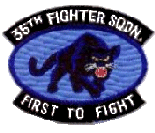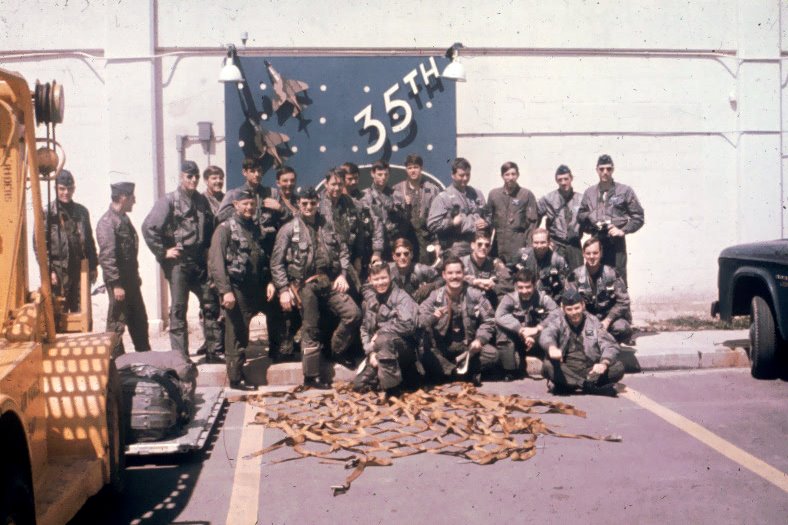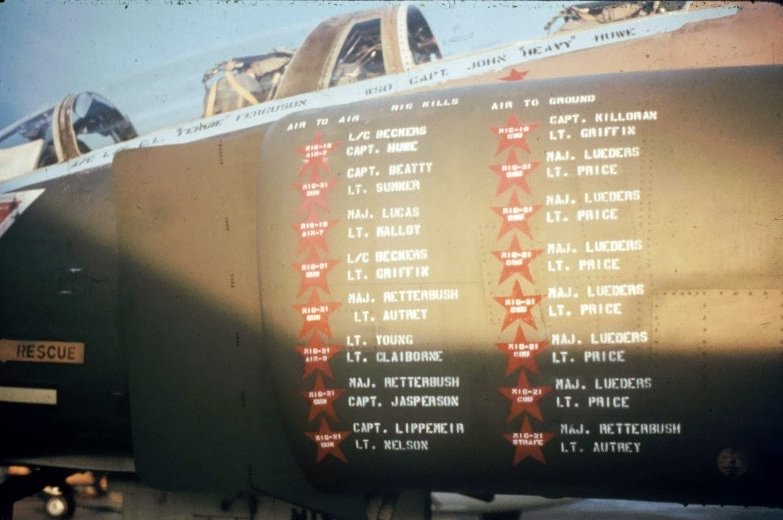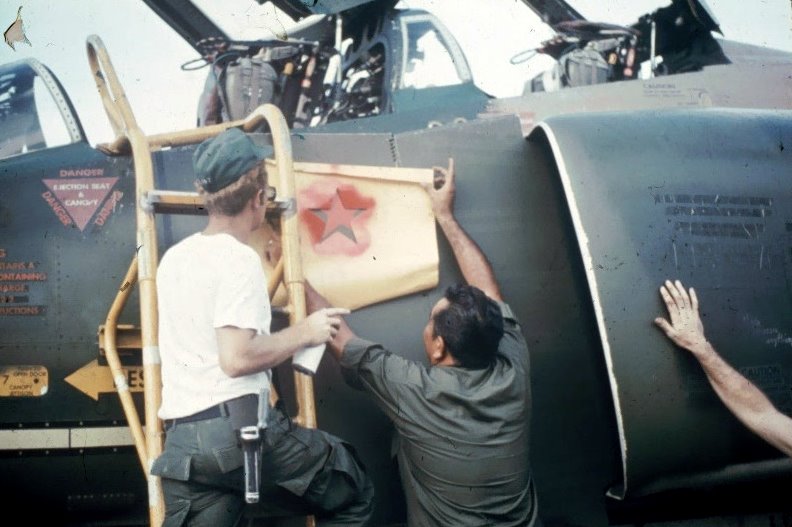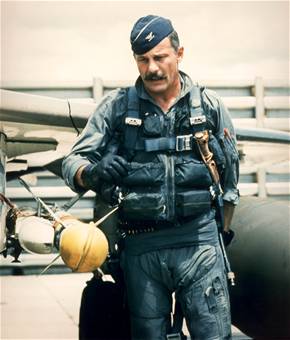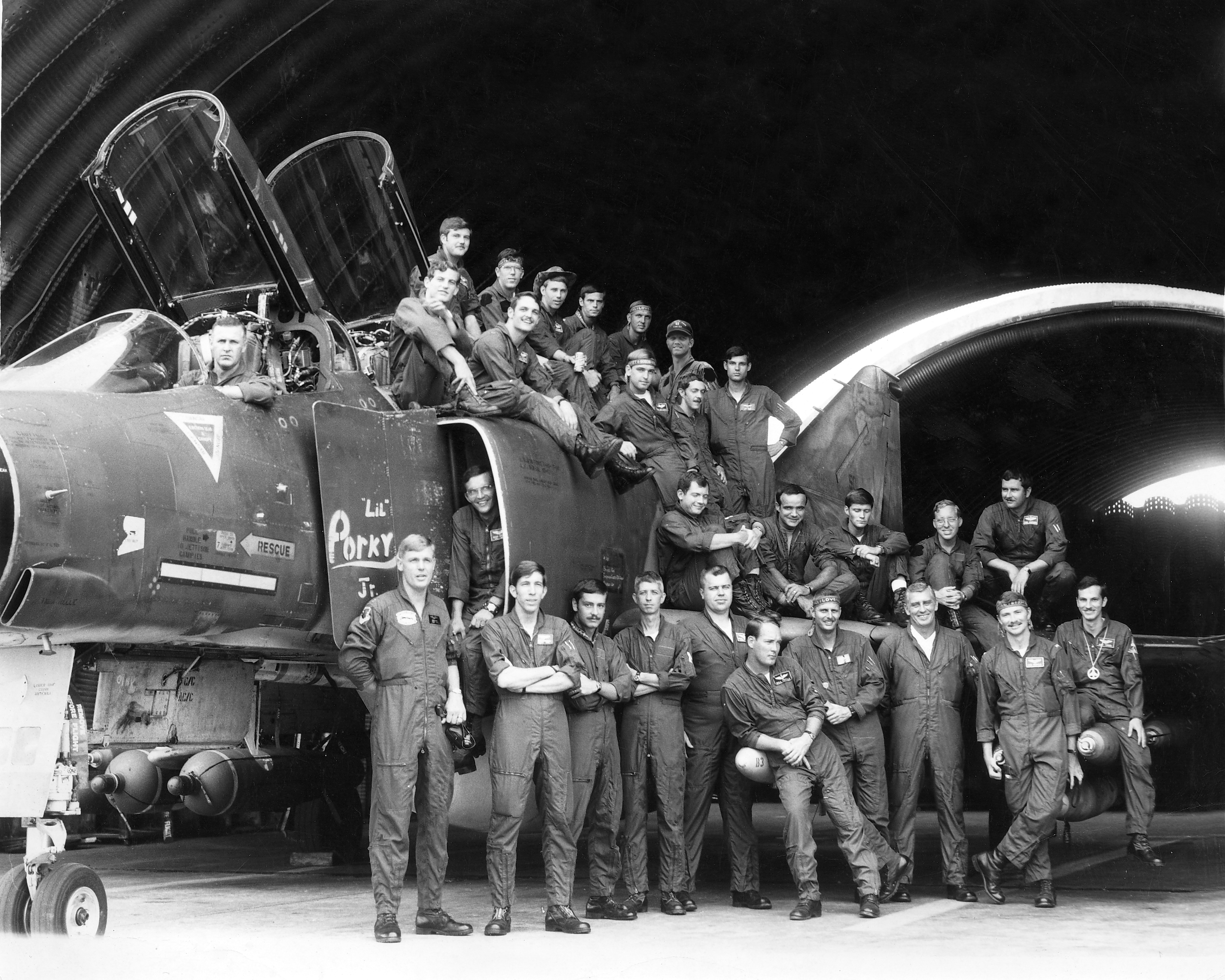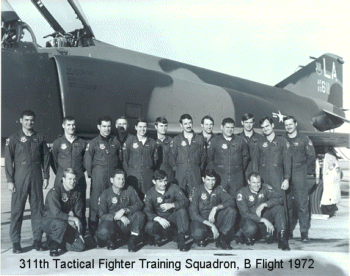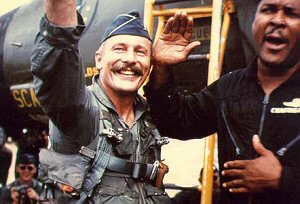by Scott Powell, Colonel, USAF, Retired
I was in the 34th Tactical Fighter Squadron at Korat Royal Thai Air Base, Thailand, in 1972. We were the “Men in Black.” I was a very junior Captain then, but had come directly from a previous assignment at DaNang Air Base, South Vietnam. All USAF squadrons in Southeast Asia seemed to be manned by junior officers. There was usually only one or two patch wearers per base, plus a handful of second tour fighter types, plus a handful of heavy drivers and (old . . . it seemed at the time) Lt. Cols who had avoided a combat tour to that point. Eighty percent were Lieutenants it seemed.
So, by virtue of having been in theatre longer, I was one of the more experienced pilots in my squadron. Fairly soon after Linebacker I commenced in 1972, I found myself leading four ship flights on the North Vietnam air raids. I always brought my flight home intact, did the job to and from the target, and never did anything operationally to embarrass my commander. So, I remained in that role throughout the summer of 1972.
I well remember the arrival of the 35th Tactical Fighter Squadron at Korat. They had a more seasoned mix of pilots and had been training operationally in Korea for things they were about to do in combat. The 34th and 469th TFS were mostly comprised of eager, but young talent that only had the benefit of a six month RTU (replacement training unit, i.e., F-4 basic flight training school) before being sent to their war theatre assignment.
Leadership of the 35th was strong. So it was the 469th, by the way. I remain loyal to my leadership in the 34th, but some have said it was a cut below the others. Future Lt. General Chuck Cunningham was one of my Ops Officers, then. He was a top notch combat leader and USAF leader. Anyway, I freely admitted while engaged in all this, that the performance of the 35th turned out to be a cut above the other squadrons. On a per-combat-day basis, they got more positive results than the other two squadrons.
Lt. Col. Lyle Beckers, squadron commander of the 35th TFS, after the war headed the Nellis Air Force Base survey of what the USAF needed to change post Vietnam. The answers turned out to be almost everything, including training, tactics, weapons, human-factor fighter design, visibility and switchology among other things. Because I had exchanged hostile missile fire over the North, I was asked for my input in that survey process. We got Fluid Four ash canned and got a decent air-to-air training doctrine out of it. There are some real Nellis heroes from that time . . . those who fought city hall. The rest is history.
The USAF and the Tactical Air Command under General Momyer at that time, did a good job of preparing RTU students for air to ground operations, but a hellatiously bad job of preparing young fighter pilots for air-to-air combat. I thought many times that the powers that be were legally negligent in failing to adequately train fighter pilots for one of their primary missions. “If I see a MiG, what do I do?” was a common refrain among those who suddenly found missiles on their aircraft instead of bombs. On paper, the USAF thought its fighter pilots were trained for aerial combat, but in reality, we were not.
Strike Escort
As Linebacker I quickly came to be organized, Korat Air Base assumed the “strike escort” role, whereby our flights of F-4Es configured with missiles instead of bombs escorted strike flights. The purpose of strike escorts was to ward off MiG attacks and protect the F-4 bombers going to and from the target area and generally help sound the alarm for threats of all kinds. So, typically, three or more flights of four F-4s of bombers and the same number of strike escorts would travel to and from the target of the day. There were some exceptions, but that role is what most of the missions up North were for the F-4 squadrons based at Korat.
On July 20, 1972, the route of the day to the target in Route Pack VI North Vietnam was over water, with all participants rendezvousing over the South China Sea northeast of Da Nang. We then proceeded north to the drop-off point with ingress from southeast of Hanoi and egress eastbound to the north of Banana Ridge, north of the Red River as it meanders toward Haiphong. A feet-wet post strike refueling gave us enough fuel to make our way back to our respective bases in Thailand.
The Long Delay
On that day, the mission briefer at Korat made a very specific point for me to wait until the preceding flight had taken off before doing so with my four ship flight. The ground choreography on that day was as precise and dramatic as any of the other Linebacker launches. We were toward the back of the parade to the runway. There was a relatively inexperienced Lt. Col. leading the flight ahead of me. The Korat arming area was large enough for two flights to arm, with spares. My flight was in position on time, next to the other flight. We armed up and were ready, but the flight ahead of me had a problem and was delayed for a long time. As more and more time passed it become apparent that making our tanker rendezvous at the designated time was going to be very difficult or impossible. The order for me to take off after the preceding flight was so public and so clear that I did not request permission to take off ahead of the preceding flight. Radio equipped supervisors were all over the place, but none of them told me to take off before the other flight. I followed orders, an old and important military tradition. We waited for the flight ahead of us to depart.
Finally, they launched. We followed immediately. I knew then that we would be lucky to even reach the tankers before they departed the track north bound. We pushed it up while we flew the 1.2 hour trek to the refueling track. We did all the normal in-flight systems checks and kept checking watches.
We were the last to arrive and got the tanker cell in sight just as they rolled out north. We cut them off and joined our assigned tanker, but with minimal time for refueling. I called my flight over to squadron common radio frequency and said, “Here’s the plan. One and two will refuel and escort our strike flight on in. Three and four, refuel after we depart. Then, take your two-ship up the coast to the egress point, perhaps you’ll be able to do some good as we’re coming out. Be sure to let the Navy know who and where you are so they don’t start calling you out as MiGs.”
Caddy 3 Goes Down
July 20, 1972, was the day Caddy 3 (Joe Lee Burns in the front and Mike Nelson in the back) got shot down. See “A Ridge Too Far,” for Joe Lee Burns’ first person account of getting shot down. Most of us egressed north of the ridge after the mission as planned, but my memory is that Joe Lee egressed south of the ridge, where he could see (and be seen) by the major line of communication east from Hanoi and its defenses. Joe would remember better, but I think it was a 57mm shell that put a big hole in his aircraft. I remember hearing the emergency beeper on guard frequency after Joe and Mike ejected and some of the radio traffic as it became clear that somebody got hit and went down. Caddy 3 managed to make it feet wet just off the mouth of the Red River in the vicinity of Haiphong. They were among the Karst islands. The rest of us were overflying them in the water on the way out of North Vietnam, but we worried about making it to our post-strike tankers to refuel.
Soon after I heard the beepers on the radio there were two rafts in the water. A fairly large unpowered water craft manned with multiple North Vietnamese from a nearby island was paddling toward our downed airmen. Meanwhile, overhead, my number 3 and 4 were taking control of the SAR (search and rescue) and trying to get the Navy to scramble its rescue resources. My second element saw the incoming sampan and went guns hot. They strafed across the bow of the gomer boat, one pass each. The gomers executed an immediate 180 degree turn and paddled even more furiously back toward their village.
Having probably never strafed over water before, our land-lubber USAF F-4 pilots both said that they almost killed themselves with the overwater strafe. It was hard to judge altitude and distance over water without any good references. As it turned out, it was fortuitous that my second element was too late to the tanker and not able to ingress into North Vietnam because they were waiting at the egress point in case they were needed. On that day, Joe Lee Burns and Mike Nelson needed their help.
Anyway, the Rescue CAP (combat air patrol) was successful. The Navy came through for the endgame and Joe Lee Burns and Mike Nelson lived to fight another day. I mentioned the happenings of the day to my Ops Officer / Squadron Commander from the perspective of my flight, in case “they” inquired about the anomaly, but nobody seemed to care. We all resumed the war the next day – business as usual.
In 1972 at Korat, there was a tactical rebellion among some of the younger F-4 pilots against the fluid four formation and its tactics. Whenever we could, we used a self-invented form of two ship formation and tactics while over North Vietnam. On July 20, 1972, my wingman was somewhat practiced and certainly willing when I told him to “assume the #3 role and position.” The strike leader uttered a negative epithet when I told him that he would be escorted by a flight of two F-4s rather than four on that day. I think we did it better. Fewer aircraft to keep track of, better proportion of resources assigned to the necessary roles, and a better fighting unit should it have been required.
© 2007, Scott Powell, All rights reserved. Reprinted with permission of Colonel Scott Powell, Fighter Pilot.
